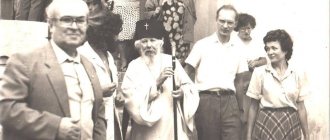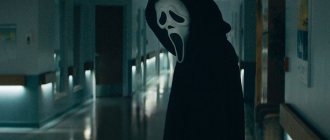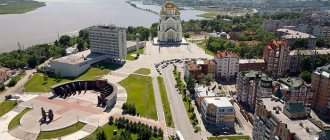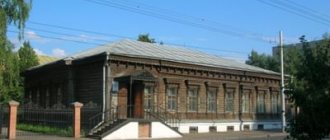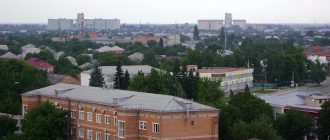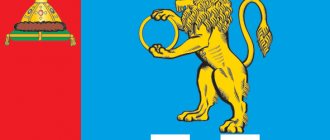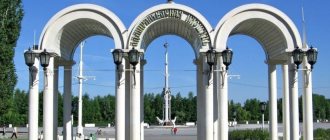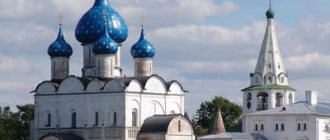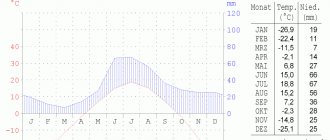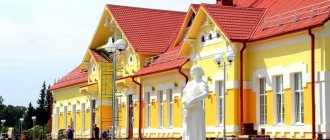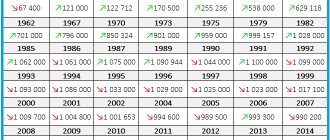| Penza, beginning XXI century |
Penza
, a city in Russia, the administrative center of the Penza region, the cathedral city of the Penza diocese. Population 517.4 thousand (2011)
- On the map: Yandex.Map, Google map
The fortress on the Penza River was founded in 1663 under Tsar Alexei Mikhailovich as an outpost on the southeastern outskirts of the state, which was easy and unprotected prey for the steppe nomads.
In May of that year, Yuri Ermolaevich Kotransky, who was previously the governor of the city of Balakhna, “to build a city,” arrived on the Penza River with a hundred Cherkasy Cossacks. He became the founder and first builder of the city. In a fairly short time, the wooden Kremlin was erected. Responsibilities for creating settlements and fortifications near the fortress were assigned to the voivodeship administration, which was headed from the end of 1663 by the first Penza voivode Elisey Protasyevich Lachinov. By decree of the tsar of October 13, he “built a settlement and settlement in Penza near the city,” that is, he allocated land to the city residents: mounted and foot Cossacks, gunners, and collars. In 1665, the city's population was about 3,300 people (almost 700 households).
For many years, the Penza fortress served as a reliable barrier against the nomads - the Kuban (peoples of the North Caucasus and Azov region) and the Nogai hordes. Penza was attacked by nomads in 1668, 1680 and 1717, but they never managed to capture the fortress. According to legend, in 1717, during the Great Kuban Pogrom, the attackers burned the southern part of the city and had already approached the walls of the fortress, but the Penza residents who were under siege appeared before the enemy army from Kazan with an icon of the Mother of God - a gift from Tsar Alexei Mikhailovich, which saved the city from destruction. The Kazan Icon of the Mother of God is to this day the main shrine of Penza.
In the first third of the 18th century, Penza turned into an internal city of Russia and lost its former strategic importance. In the second half of the 18th century, the Penza region became one of the main areas of landownership in the country. By this time, Penza was a major economic center, the prosperity of which was based on commercial agricultural production (mainly the export of grain) and distillation.
Since 1719, Penza has been the center of the Penza province of the Kazan province. In 1780, the city became the center of the Penza governorship, subordinate to the Kazan governor-general.
On September 9, 1801, Penza was declared a provincial city, being at the same time the center of the Penza district. The governor's residence was located in Penza.
In the 1800s Penza's population was about 13,000 people.
| Penza, view from the cathedral, pre-revolutionary photograph |
In connection with the sharp increase in the administrative apparatus in the provincial Penza, the number of nobles and officials increased significantly, which, together with the opening in the city at the end of the 18th - beginning of the 19th centuries.
educational institutions and its extremely active theatrical and musical life for the Russian province of those years, made Penza a major cultural center. Thanks to the large number of cultural and educational institutions at the turn of the 19th century. Penza was nicknamed “New Athens”. Penza was traditionally located at the intersection of important trade routes, and by the end of the 19th century. received railway access in all directions: on October 11, 1874, traffic began on the Morshansk-Syzran section. This circumstance created good preconditions for economic and cultural development. The epithet of a “merchant” city was firmly assigned to Penza; in the economy of Penza, the leading role belonged to the trade in bread and alcohol and the food industry, especially flour-grinding and vodka.
According to the All-Russian census of 1897, 59,981 people lived in Penza; by 1917, the population was 105,000 people.
On January 3, 1918, Soviet power was established in Penza. In the first post-revolutionary years, Penza found itself in the epicenter of a civil war: peasant uprisings broke out in the villages of the province, and in May 1918, bloody battles took place in the city with the rebel troops of the Czechoslovak corps.
On February 4, 1939, the Penza region was formed. By that time, the city's population was 160 thousand people.
In the first years of the Great Patriotic War, Penza turned into one of the most powerful centers in the country for the production of mortar weapons: on the basis of local and food industry enterprises that existed in the city, equipment from factories evacuated from other cities was deployed.
Religion
Since 1799, Penza has been the cathedral city of the Penza diocese.
Shrines
- Penza Icon of the Mother of God
Monasteries
- Trinity Convent
Temples
- Annunciation of the Blessed Virgin Mary
- Annunciation of the Blessed Virgin Mary, baptismal church
- Holy Spirit of the Descent, Trinity Monastery Church
- Innocent of Irkutsk
- Mitrofan of Voronezh, cemetery
- Michael the Archangel, temple-chapel
- Holy Image, chapel
- Nicholas the Wonderworker
- Peter and Paul
- Intercession of the Blessed Virgin Mary, Cathedral
- Transfiguration of the Lord, ex. Spaso-Preobrazhensky Monastery
- Nativity of Christ, church-chapel
- Sergius of Radonezh, temple-chapel
- Trinity Life-Giving, Church of the Trinity Monastery
- Assumption of the Blessed Virgin Mary, Cathedral
Penza
Central Park of Culture and Leisure named after V. G. Belinsky
© Sergey Arkhipkin
Since 1936, Penza has had a slightly different division into territorial administrative units. The city had three districts: Northern, Zavodskoy and Southern. Since 1962, due to the increase in the number of residents and the development of industry and infrastructure in Penza, the boundaries and names of territorial associations begin to change. Then Leninsky and Oktyabrsky districts appeared, and a year later Zheleznodorozhny was formed. And in 1979, the division of the city ended with the emergence of the Pervomaisky district.
Leninsky district
This district was formed in 1962 on the territory of the former Southern District. This is the smallest territorial unit of the city, geographically located in the center of Penza. Leninsky district is considered the oldest part of the city. It was here that many significant events took place. The streets of the district remember famous people who were able to increase the glory of Penza and all of Russia. In this part of the city there are several museums, cinemas, and educational institutions. The publication of the Penza Circus, Youth Theater, Philharmonic Society, and the Central Park of Culture and Leisure named after V. G. Belinsky are also located here.
The region's industry is represented by seven large enterprises and four research institutes. These institutes develop technologies for flight simulators, railway control and other areas. Here they are engaged in the creation of instruments and sensors for monitoring physical quantities. In this part of Penza there is a pedagogical institute named after V. G. Belinsky, 9 special educational institutions, many gyms, 4 sports schools, 10 swimming pools.
The area of the district is 27.5 square kilometers and is home to 94.5 thousand people.
Oktyabrsky district
Oktyabrsky district appeared on the city map in 1962. A third of all urban economic entities of various forms of ownership are located in this part of the city. There are many enterprises here that make up the main industrial potential of the Penza region. Among them are Radio, Meat and Poultry Plant Penza and others.
The population's needs are met by almost 30 large shopping centers, the largest of which are “Collage” and “Berlin”. There are two universities in the region: the Technological Academy and the Penza University of Architecture and Construction. There are also two recreation parks for citizens, 6 libraries, 3 Palaces of Culture and other institutions for children's and adult recreation.
According to data for 2022, 181 thousand people live in the Oktyabrsky district on an area of 81 square kilometers.
Zheleznodorozhny district
Appeared on the city map in 1963. And it got its name because of the transport railway junction located on its territory, consisting of enterprises, stations and the Railway Administration for this region. There are several large transport, trade, construction organizations in the area, large enterprises “Biosintez”, “Bread Products Plant”, “ZhBI-1” and others. Products from local factories, such as shut-off pipeline valves, reinforced concrete structures, paper, and wallpaper, are in demand throughout Russia. Here in the area is the Central Market of Penza.
Sleeping area Penza, st. Pushkin
© Sergey Arkhipkin
There are more than 20 preschool institutions, 15 schools in the area, and the Penza Agricultural Academy is located here. There are several cultural institutions, sports facilities are represented by swimming pools, the Golden Puck sports and ice complex, and the Olympic Sports Palace.
As of 2022, the population of the Zheleznodorozhny District is 115 thousand people living on an area of 145 square kilometers.
Pervomaisky district
The Pervomaisky district of Penza appeared due to the annexation of several outlying villages to part of the Leninsky district. This happened in 1979. The area of the new territorial-administrative unit was 50 square kilometers, where in 2022 there were 134.5 thousand people.
The city's air gateway, Penza Airport, is located in the area. There are also many large and medium-sized enterprises in the machine-building complex and the food industry. The company CJSC NPP MedEng, which produces artificial heart valves, is internationally famous.
The district's medical institutions are represented by the Regional Clinical Hospital named after N. N. Burdenko (with a museum dedicated to him), an ophthalmological hospital, a rehabilitation center and other organizations. One and a half dozen secondary schools and 25 kindergartens have been created for educational services. Higher education can be obtained at Penza State University. There is the Penza Zoo, a folk art museum, and the country's oldest puppet theater.
The city of Sputnik and its attractions
Where is Sputnik located in Penza? In the southern part of the city there is the Pervomaisky district (an area of more than 50 km²). It was created in 1979 by annexing several villages located near Penza.
Once upon a time there was a large field and a sand quarry on this site. For 10 years, under the leadership of the regional leadership, construction work was carried out and urban infrastructure was created.
Now this territory is considered a city within a city, where more than 20 thousand people live (area - 275 hectares). Residential areas, kindergartens, schools and other city institutions have been created here. The main attractions are the embankment, located on the shore of an artificial lake, and the light and sound fountain built in 2014.
This attraction consists of a complex of three fountains that are controlled by a computer system. In the evening, thanks to the lighting, which changes to the beat of the music, it looks especially attractive. The building is located on Naberezhny Boulevard and is a popular vacation spot for residents and guests of the city of Sputnik.
Coat of arms
The coat of arms of Penza is presented in the form of a French shield. The ratio of width to height is 4:5. It depicts (in a green field) three golden sheaves: wheat, barley and millet. They stand on the ground the color of the same precious metal and indicate the wealth and agriculture widespread in the area.
The artistic composition was adopted by the decision of the Penza City Duma of December 28, 2001 No. 186/13. Borrowed from the emblem of the Penza regiment. Included in the State Heraldic Register of the Russian Federation under No. 972.
Popular message topics
- Music of the Renaissance
During the period from the 14th to the 16th centuries, the Renaissance reigned in Europe. This is an era of rapid growth of artistic culture, which was reflected in music and significantly transformed its appearance. Composing and performing music acquired special significance during this period. - Forest protection
You and I live in a country rich in the largest number of forest spaces. In our country, most of the land is in forests. So why spoil these wonderful statistics and destroy a priceless gift. - Shishkin Ivan Ivanovich
Ivan Ivanovich Shishkin was born into a merchant family on January 25, 1832, in the Russian Empire. The Shishkin family was famous for its ancient origins. Ivan Ivanovich is a famous Russian landscape artist, painter, and engraver.
Toy railway
Penza Children's Railway, located on the outskirts of the city near the village of Sosnovka, is one of the main attractions. Since 1985, the educational and entertainment children's complex has become a favorite vacation spot for Penza children and city guests.
The length of the ring road is 1.5 km and runs through a forest area where two intermediate stations are located - Pionerskaya and Sosnovka. A special feature is that this narrow-gauge railway is operated by children under the guidance of railway mentors.
How to get to Penza?
Where is Penza located? We have already found this out. How to get to the city from Moscow? Depending on your financial capabilities, you can get to Penza by choosing one of three options.
You can use the services of airlines. Planes depart from Domodedovo and Vnukovo and land at Bolshoye Savino International Airport 1.5 hours later. The ticket price is approximately 7,000 rubles.
The Moscow-Orsk and Moscow-Penza trains arrive at the main railway station of Penza.
Trains depart from Kazansky station. And they arrive in Penza in 14-15 hours. The ticket price will cost 1,150 rubles (reserved seat) or 1,810 rubles (compartment).
In Moscow, three bus stations (Kazansky, Shchelkovsky, South Gate) send long-distance buses from Moscow to Penza. Travel time is approximately 14-15 hours. Ticket price starts from 1200 rubles.
Penza map
If you are wondering where Penza is on the map of Russia, you need to look southeast of Moscow. It is located approximately at the latitude of Samara, north of Saratov. Nearby are cities such as Tambov, Saransk, Syzran, Ulyanovsk.
A map of Penza shows that the city is crossed from west to east by the M5 highway, and from north to south by the Sura River. It covers an area of more than 300 km2. Three main streets pass through the center: Volodarskogo, Kirov and Moskovskaya. The latter is notable for being pedestrian. That's why it is also called Penza Arbat.
Penza is a very green city. Almost in the center there is a Botanical Garden and a large zoo. The climatic resort of Akhuny is located nearby. The city itself has many parks and squares, so it is considered one of the greenest in Russia.
Story
The history of Penza begins in 1663. By decree of Tsar Alexei Mikhailovich, a fortress was founded that protected the southeastern outskirts of the Russian kingdom. In 1719, the settlement became part of the Kazan province. At the end of the 18th century it was declared a provincial town. Soon he became a district member. Entertainment and educational institutions began to open there. Factories and an iron foundry were erected.
On October 11, 1874, a section of the Morshansk–Syzran railway was launched. This facility contributed to the development of the food industry. The emergence of Soviet power led to uprisings and armed struggle against the Bolsheviks. On February 4, 1939, the region of the same name was formed.
During World War II, evacuated enterprises supplying the front were located here. As part of the Russian Federation, it retained its status as a cultural and industrial center of the Volga region.
Cathedral
On the central alley of the Mironositsky cemetery there is the Assumption Cathedral. In 1836, there was a wooden church on this site. 63 years later, during a city fire, it burned down. And in 1905, on the foundation of the burnt temple, a stone cathedral with three altars was built.
In 1937 the cathedral was closed, and for eight years it housed army warehouses. From 1945 to the present time, liturgies and church services have been held in the cathedral. They can be attended by tourists and city guests. Since 2000, a Christian school for children and adults and theological educational courses have been operating on the territory of the Cathedral.
Climate and geographical location of Penza
Geographical position
Penza is located in the center of the European part of Russia on the Volga Upland, 629 km (along the M-5 Moscow - Chelyabinsk highway) southeast of Moscow. The city is located on both banks of the Sura River. The area of the city is 304.7 km².
The average height above sea level is 174 m. The highest point (280 m above sea level) is located on the Battle Mountain hill, stretched from SW to NE like a ridge. The lowest is 134 m.
Hydrography
The length of Penza from north to south is 19 km, from west to east – 25 km.
The city is located on both banks of the Sura River. In addition to the Sura (the main water artery of the city), the rivers Penza, Penzyatka, Ardym, Staraya Sura, Moika, Barkovka, and the Prokop and Bezymyanny streams flow through the city. Some of them, partly within the city, flow in sewers.
The main river recreation area in Penza is Staraya Sura. In the area of Staraya Sura, 3 large subdistricts of the city are connected - the Mayak factory microdistrict, Angarskaya street and the GPZ-24 microdistrict. It is located in the south-eastern part of the city and is the largest equipped bathing area in the city, on which there are 4 beaches (the beach near the Mayak factory and 3 city beaches: Detsky (1st Angarsky Lane), Sredny and Bolshoi (GPP area -24, Antonova St.) The river originates outside Penza, in the form of a stream flowing from the Sursky reservoir and flows as a small river through Akhuny; in the GPZ-24 microdistrict it turns into a reservoir in the area of Angarskaya and Vereshchagina streets, and then flows into reservoir near the dam in the area of the Mayak factory and again flows into the Sura.
Timezone
Geographically, Penza is located in the center of the third time zone and is included in the time zone designated by the international standard as the Moscow Time Zone (MSK). The offset from UTC is +3:00.
Flora and vegetation
In accordance with the general plan of Penza, approved in 1973, the total area of the green zone was more than 25% of the total area of the city and, according to this indicator, was recognized in the 1980s as the greenest city in the Volga region, but since 1990 there has been an intensive reduction in city squares, suburban green areas and parks due to development of the territory.
Natural forest plantations in the urban area are represented on the left bank of the Sura, mainly by broad-leaved forests (oak forests with linden, maple, aspen and birch), on the right bank of the Sura - by pine-broad-leaved forests; total area is about 9.5 thousand hectares.
On the territory of Penza there is a botanical garden named after I. I. Sprygin (established in 1917), divided into three sections: dendrological (about 230 plant species), systematic (about 200 plant species) and floral and ornamental (more than 100 plant species), where plants of the flora of North America, Europe, Central Asia, Siberia, the Far East, China and other regions are presented.
Climate
The climate of Penza is moderate continental. Winter in Penza is moderately cold and long, lasting from early November to late March, the coldest month is February with an average temperature of −9.1 °C. Summer is warm, lasting from late May to early September, with an average July temperature of 20.4 °C. The average annual temperature is 5.5 °C. The climate of Penza is close to Moscow, but it is more continental and receives less precipitation.
| Climate of Penza (norm 1981—2010) | |||||||||||||
| Index | Jan. | Feb. | March | Apr. | May | June | July | Aug. | Sep. | Oct. | Nov. | Dec. | Year |
| Absolute maximum, °C | 7,0 | 8,5 | 17,3 | 31,1 | 35,6 | 37,7 | 39,3 | 40,4 | 33,6 | 25,6 | 16,1 | 11,0 | 40,4 |
| Average maximum, °C | −5,5 | −5,1 | 1,0 | 12,4 | 20,8 | 24,8 | 26,6 | 24,7 | 18,2 | 9,9 | 0,6 | −4,4 | 10,3 |
| Average temperature, °C | −8,7 | −9,1 | −3,4 | 6,8 | 14,3 | 18,5 | 20,4 | 18,3 | 12,5 | 5,6 | −2,1 | −7,4 | 5,5 |
| Average minimum, °C | −11,9 | −12,5 | −7,2 | 1,9 | 8,1 | 12,7 | 14,7 | 12,8 | 7,7 | 2,2 | −4,6 | −10,3 | 1,1 |
| Absolute minimum, °C | −39,9 | −40 | −31,1 | −20 | −5,6 | −1,1 | 4,7 | 0,0 | −6,4 | −17,2 | −31,1 | −40,5 | −40,5 |
| Precipitation rate, mm | 38 | 31 | 35 | 33 | 42 | 65 | 59 | 51 | 52 | 47 | 48 | 41 | 542 |
The length of the day on December 21 is 7 hours 32 minutes, on June 21 - 16 hours 57 minutes.
According to the site https://ru.wikipedia.org/ as of 08/13/2015
Project on the theme “My hometown is Penza” for 2nd grade
Goal of the project: As part of studying the subject “The World Around You,” talk about your hometown, its attractions and memorable places.
Find information about his story and share it with your classmates. Tell schoolchildren about Penza and why I love it. Prepare a report and presentation in the form of a photo story. Project plan:
- Location on the country map.
- History and symbols.
- Penza in the present.
- Attractions.
- Places of military glory.
- Conclusion.
- An example of a finished photo story-presentation.
